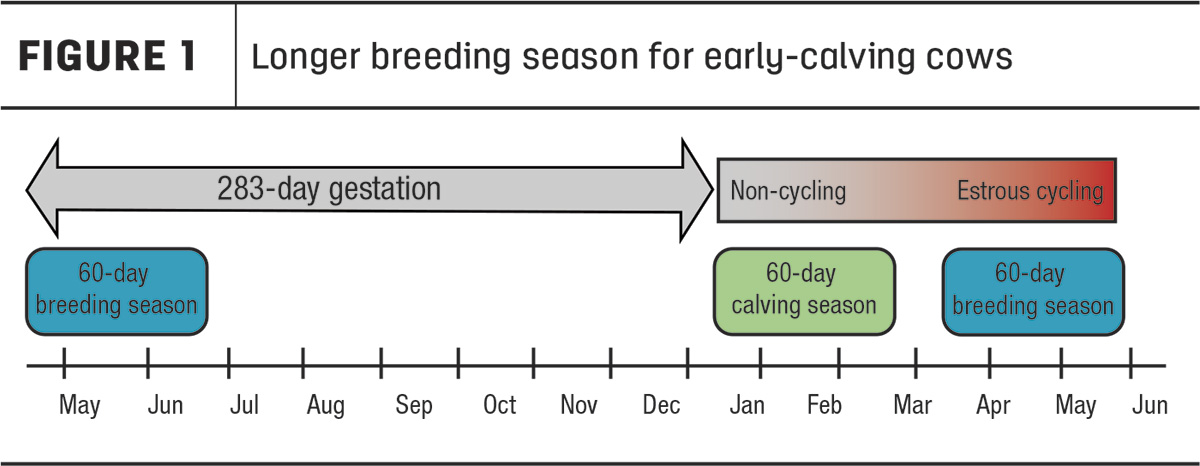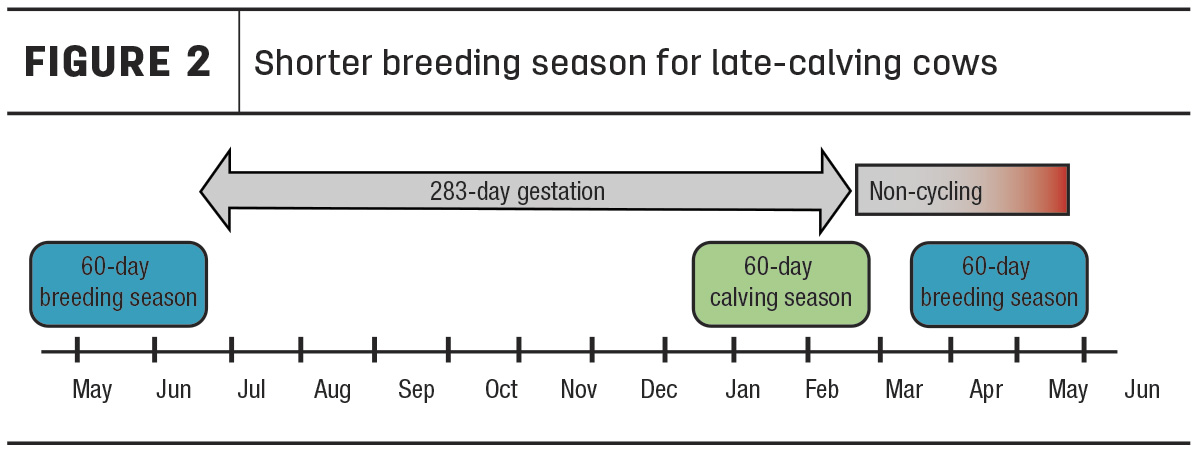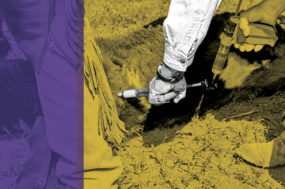The reproductive efficiency of cow-calf operations is one of the most important factors affecting the potential profitability of herds. The ideal cow calves early in the calving season every year, breeds back early in the breeding season and weans off a heavy calf year after year. There are numerous factors that affect the cow’s ability to produce at its maximum efficiency. This article examines some of those factors and how to use best management practices to allow heifers and cows to perform to their maximum potential.
The calving interval
First, it is important to understand why it may be a challenge for cows to maintain a 12-month calving interval year after year. To support this cycle, cows must be inseminated and become pregnant within 85 days post-calving (280-day gestation + 85 days = 365 days). In addition, cows generally require 30 to 45 days post-calving for uterine involution and postpartum recovery. As shown in Figure 1, when a cow breeds on day one of a typical 60-day breeding season and calves on day one of the subsequent 60-day calving season, she will optimize her ability to breed back on the yearly cycle.

Cows that calve early in the calving season have more time to go through a noncycling phase (when cows don’t show heat following calving) and subsequently begin to show estrus prior to the next breeding season, ultimately increasing their opportunity to become pregnant again. However, if a cow calves at the end of the calving season (Figure 2), she will have less opportunity to get bred and become pregnant in the 60-day breeding season and will most likely be nonpregnant (open) when the breeding season comes to an end. Keeping the entire cow herd in a 12-month calving interval is not an easy task, but there are several reproductive management programs (i.e., estrus synchronization program with natural service and/or A.I.) that can assist in accomplishing it.

Pregnancy diagnosis
Another tool to help maintain a controlled breeding season and identify the heifers and cows that will be calving earlier in the calving season is the utilization of pregnancy diagnosis. Pregnancy diagnosis can be performed via ultrasound examination (after about 30 days), blood analysis (after about 30 days) or rectal palpation (after about 35 days). Each of these options offers a highly accurate way to determine pregnancy when performed by a skilled technician or veterinarian. One of the benefits of rectal palpation and ultrasound is the ability to access the fetal age of the pregnancies, and this can usually be done earlier in pregnancy (120 days or less) with high accuracy. Identifying fetal age and sex using ultrasound of heifers and cows provides more information to help make the “keep or cull” decision when that time comes. It also allows producers to better manage their subsequent calving season because they know which females will be calving in the first few weeks of the season and which will be calving later. This also allows these two groups to be managed differently, if applicable. If more pregnant females are available than are needed for replacements, producers can identify the earlier-calving females to retain in their herd and sell the later-calving females as bred replacements.
Another area that can contribute to the reproductive success of the cow herd is replacement heifer development and genetic selection. Each individual operation has its idea of the ideal fertile cow. Some prefer cattle with more performance and growth, while others prefer a more moderately sized cow that can thrive on minimal feed resources. Fertile cows can exist in both of these scenarios! Genetic selection for fertility is lowly heritable in beef cattle, but there are expected progeny differences (EPDs) and selection indexes (heifer pregnancy EPDs, stayability EPDs and cow profitability indexes), which can lead to selection for more fertile females. When looking at potential future bulls for natural service or A.I., producers should place some selection pressure on these fertility traits to start to make progress in the herd. Understand that the sire selection decisions made in an individual year won’t be realized until those females are brought back into the herd, and several generations of selection will result in more profitable cows.
Bull analysis
Finally, don’t forget about the bull! Breeding soundness examination of the bull’s reproductive tract and semen evaluations by a qualified technician or veterinarian should be performed at least 30 days prior to introducing the bull to females. Producers should monitor the bulls in the pasture to ensure they are breeding females as they come into heat and continue to monitor those cows to ensure those breedings were reasonably successful. The number of females a bull can successfully breed in a breeding season can vary based on the bull’s age, physical condition (good body condition and no injuries) and libido.
These are only a few of the ways to help manage a cow herd to improve the reproductive and financial success of the herd. Reach out to industry professionals and veterinarians to discuss ways to improve the ultimate success of your cow herd.








